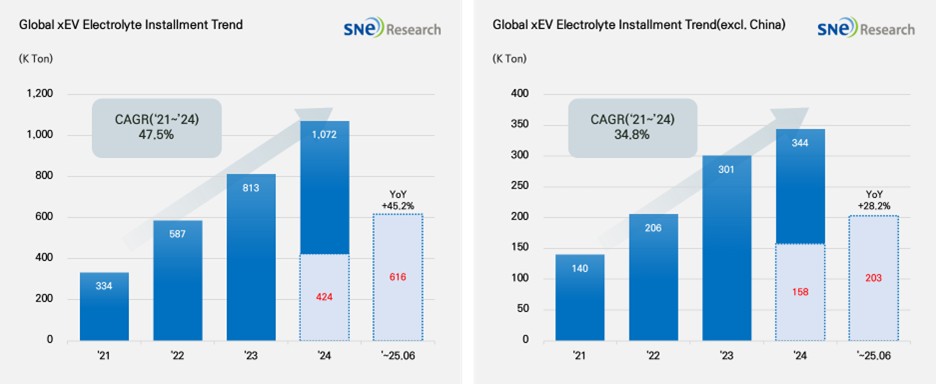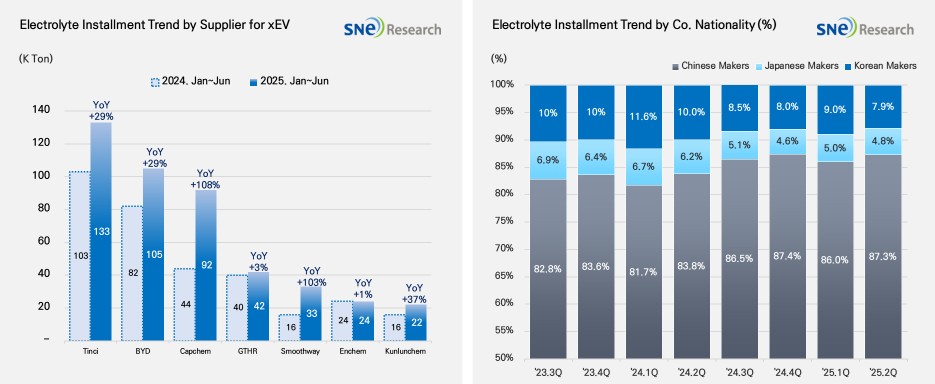From Jan to June in 2025, Global[1] Electronic Vehicle Battery Electrolyte Installment[2] Reached 616K ton, a 45.2% YoY Growth
- In 2025 H1, the electrolyte market continued to post a double-digit growth, while the non-China market showed a stable expansion in demand

(Source: 2025 July Global EV & Battery Monthly Tracker (Incl. LiB 4 Major Materials), SNE Research)
From Jan to June in 2025, the total installment of electrolyte used in electric vehicles (EV, PHEV, HEV) registered around the world was approx. 616K ton, showing a 45.2% YoY growth. Particularly in the non-China market, the total usage of electrolyte posted 203K ton and 28.2% YoY growth, continuously seeing a stable expansion in demand.
Electrolyte is one of the key materials and facilitates the transfer of lithium ions inside batteries, directly affecting the battery charging speed, safety, and battery life. With the electric vehicle market expanding and demand for high-performance batteries increasing, the electrolyte market is expected to continue steady growth in the mid to long run.
From Jan to June in 2025, the global electrolyte market saw noticeable growth among major electrolyte suppliers. Tinci was the world No.1 electrolyte supplier, whose electrolyte installment reached 133Kton, a 29.3% YoY growth. BYD followed Tinci on the list with 105Kton, a 28.8% increase. Capchem showed a high growth of 107.9% with 92K ton, while GTHR’s 42K ton electrolyte was used in batteries installed in electric vehicles. Smoothway exhibited a 103.3% growth, recording 33K ton. The Korean suppliers such as Enchem and Soulbrain posted 24K ton(+0.8%) and 18K ton (+22.2%) respectively, maintaining steady growth.

(Source: 2025 July Global EV & Battery Monthly Tracker (Incl. LiB 4 Major Materials), SNE Research)
In terms of market shares of companies by their nationality, the Chinese electrolyte suppliers are still leading the electrolyte market. As of Q2 2025, the market shares taken by the Chinse electrolyte companies were 87.3%, while the Korean and Japanese companies took up 7.9% and 4.8%, respectively. The market shares held by the Korean and Japanese electrolyte makers were slightly lower than the same period of last year, showing that the Chinese companies have been strengthening their market dominance and it has become even more important for the non-China companies to secure their own competitive edge.
In the recent electrolyte market, technological directions and competitive dynamics are shifting in line with the trend toward higher output in electric vehicles and the commercialization of next-generation batteries. In particular, with the full-scale introduction of new battery technologies such as all-solid-state batteries and high-voltage, high-energy-density cells, electrolyte manufacturers are accelerating the development of products with high safety and durability.
As demand for premium electrolytes increases, strategic collaborations with global OEMs for joint technology development are emerging as a key to securing new competitiveness, and materials companies in Korea and Japan are actively leveraging this as an opportunity.
In addition, as the trend of expanding demand outside China continues, the push for supply chain localization in North America and Europe is prompting the electrolyte industry to adopt regional diversification strategies. Accordingly, some major companies are enhancing their customer responsiveness by securing local production bases, while also working to expand long-term contracts based on establishment of a stable supply chain.
The electrolyte market is expected to continue growing in the future, driven by the wider adoption of electric vehicles and the spread of high-performance battery technologies. In particular, companies that achieve differentiation in terms of technology, quality, and supply stability are likely to gain an advantage during the medium- to long-term market restructuring process, and competition among electrolyte manufacturers focused on technological capabilities is expected to intensify further.
[2] Based on batteries installed to electric vehicles registered during the relevant period.

